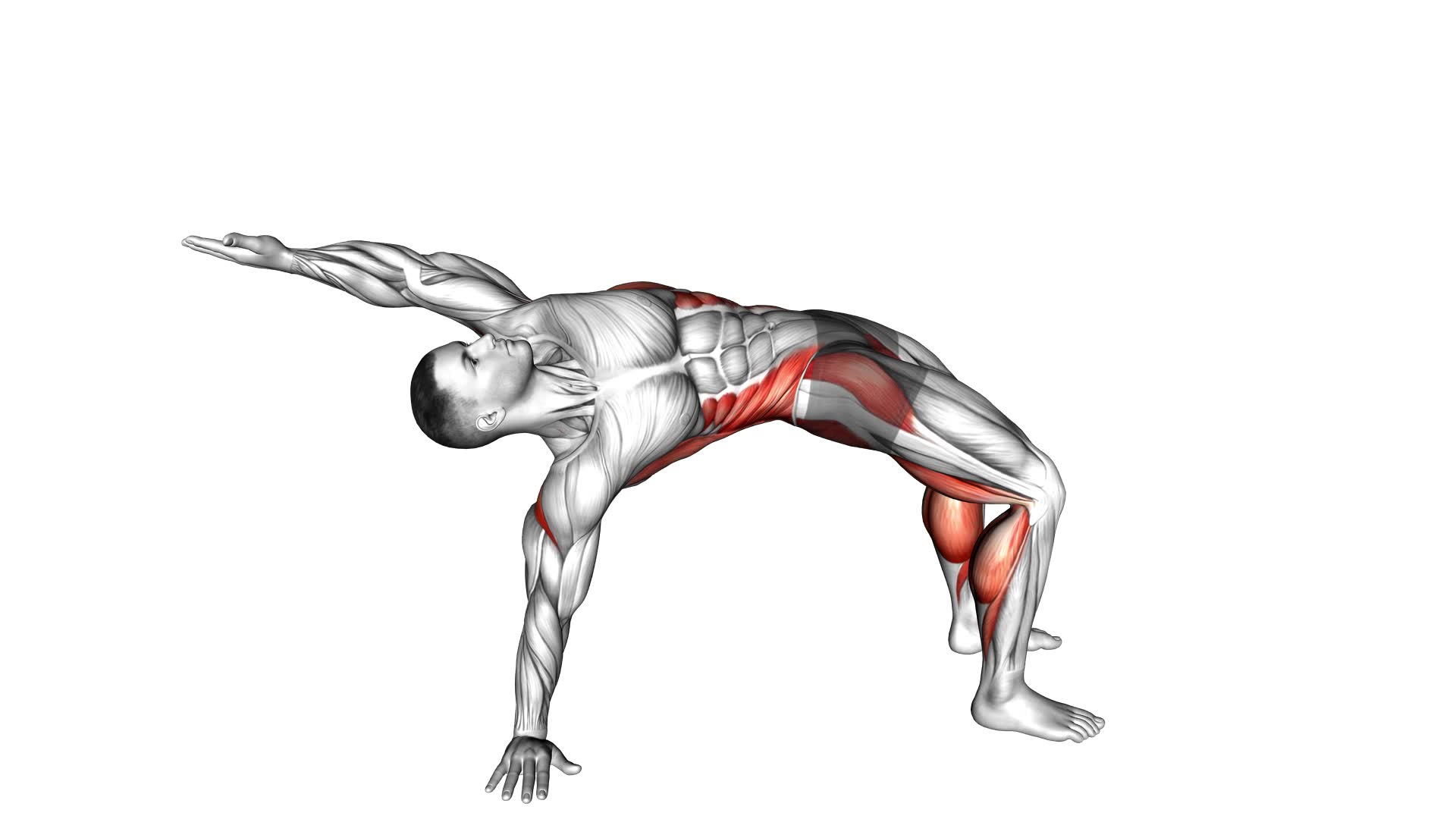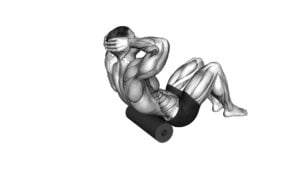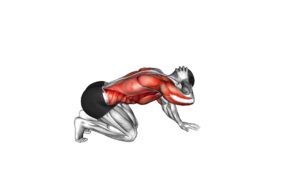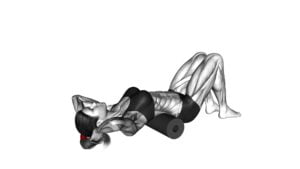Thoracic Bridge – Video Exercise Guide & Tips

Looking to improve your thoracic mobility and core strength? Check out our video exercise guide for the thoracic bridge.
Watch This Exercise Video
This informative and concise tutorial will walk you through the proper form and technique, as well as common mistakes to avoid.
With variations and progressions included, you can tailor the exercise to your fitness level.
Follow our tips for a safe and effective workout, and start incorporating the thoracic bridge into your routine today.
Key Takeaways
- The Thoracic Bridge improves range of motion in the thoracic spine.
- It counteracts the effects of sedentary lifestyles and poor posture.
- The exercise strengthens the muscles of the core and enhances hip mobility and stability.
- Incorporating the Thoracic Bridge into your routine can improve posture and promote a more upright position.
Benefits of the Thoracic Bridge
The Thoracic Bridge offers numerous benefits for your overall flexibility and core strength. This exercise is a great way to improve your range of motion in the thoracic spine, which is the middle portion of your back. By performing the Thoracic Bridge regularly, you can increase your flexibility in this area, allowing for better rotation and extension of the spine.
One of the advantages of the Thoracic Bridge is that it helps to counteract the effects of sedentary lifestyles and poor posture. Many people spend a significant amount of time sitting, which can lead to tightness and stiffness in the back. The Thoracic Bridge helps to reverse these effects by mobilizing the spine and stretching the muscles of the back.
Another benefit of the Thoracic Bridge is that it strengthens the muscles of the core. As you perform this exercise, you engage your abdominal muscles, obliques, and lower back muscles. This can lead to improved stability and balance, as well as a stronger core overall.
Incorporating the Thoracic Bridge into your workout routine can also help to improve your performance in other exercises and activities. By increasing your flexibility and core strength, you may find that you have better form and can lift heavier weights or perform more advanced movements.
Proper Form and Technique
To perform the thoracic bridge with proper form and technique, there are a few essential techniques you need to keep in mind.
First, make sure to engage your core muscles throughout the entire movement to maintain stability and control.
Second, avoid arching your lower back or letting your hips sag, as this can put unnecessary strain on your spine.
Lastly, be mindful of common form mistakes such as rushing the movement or not fully extending your hips, as these can compromise the effectiveness of the exercise.
Essential Techniques for Form
Start by focusing on your form and technique to ensure you're performing the thoracic bridge correctly. Proper form is crucial for maximizing the benefits of this exercise.
To improve posture, make sure to keep your shoulder blades engaged and pulled back throughout the movement. This will help counteract the effects of slouching and promote a more upright position.
Additionally, focus on increasing mobility by actively rotating your spine and opening up your chest as you bridge up. This will help to release tension and tightness in the thoracic region, allowing for greater range of motion.
Remember to maintain a strong core and stable base throughout the exercise to support your body and prevent injury.
Common Form Mistakes
Improve your thoracic bridge form and technique by avoiding these common mistakes:
- Rounding your shoulders: Keep your shoulder blades pulled back and down to improve your posture and prevent shoulder pain.
- Arching your lower back: Maintain a neutral spine by engaging your core and tucking your tailbone under. This helps prevent strain on your lower back.
- Lifting your hips too high: Find a balance between lifting your hips and keeping your body aligned. Avoid excessive hip elevation to prevent unnecessary strain on your shoulders.
By correcting these common form mistakes, you can enhance the effectiveness of the thoracic bridge exercise while improving your posture and avoiding shoulder pain.
Keep in mind that proper form and technique are essential for achieving the best results and minimizing the risk of injury.
Common Mistakes to Avoid
To ensure your safety and prevent discomfort or injury, it's crucial to improve your form when performing the thoracic bridge exercise.
Avoid common mistakes such as arching your back too much or letting your shoulders collapse.
Improve Form for Safety
To ensure safety and proper form during the thoracic bridge exercise, focus on maintaining a strong and stable core throughout the movement. This won't only help protect your lower back but also improve your overall posture and increase mobility.
Here are some common mistakes to avoid when performing the thoracic bridge:
- Allowing your hips to sag: Keep your hips lifted and in line with your shoulders to maintain a straight and stable position.
- Neglecting proper shoulder alignment: Make sure your shoulders are stacked directly over your wrists to avoid strain on your wrists and shoulders.
- Forgetting to engage your glutes: Squeeze your glutes to help stabilize your body and prevent excessive arching of the lower back.
Prevent Discomfort and Injury
To prevent discomfort and injury during the thoracic bridge exercise, you need to be mindful of the following common mistakes and make sure to avoid them.
- Avoid using excessive force or momentum when transitioning between positions. This can strain your muscles and increase the risk of injury. Instead, focus on controlled and smooth movements.
- Maintain proper alignment throughout the exercise. Make sure your shoulders, hips, and knees are all in line to prevent unnecessary strain on your joints.
- Listen to your body and avoid pushing yourself too hard. Start with a comfortable range of motion and gradually increase it over time.
Maximize Exercise Effectiveness
To maximize the effectiveness of your thoracic bridge exercise and avoid common mistakes, focus on maintaining proper form and engaging the correct muscles throughout the movement. Here are some tips to help you maximize results and increase efficiency:
- Keep your core engaged: By activating your core muscles, you can stabilize your body and maintain proper alignment during the exercise.
- Control your breathing: Breathe deeply and exhale as you lift your hips, maintaining a steady rhythm to support your body's movement.
- Use full range of motion: Aim to fully extend your hips and shoulders, allowing your body to stretch and strengthen the muscles involved in the thoracic bridge.
Variations and Progressions
Explore different variations and progressions of the thoracic bridge exercise to challenge your core strength and improve your mobility.
Variations of the thoracic bridge can be done to target different muscle groups and add variety to your routine.
One variation is the single-leg thoracic bridge, where you perform the exercise with one leg extended straight out in front of you. This variation adds an extra challenge to your core stability and balance.
Another variation is the weighted thoracic bridge, where you hold a weight, such as a dumbbell or kettlebell, on your hip while performing the exercise. This variation increases the resistance and intensity of the exercise, helping to build strength and muscle.
Progressions of the thoracic bridge can be done to further enhance your core strength and mobility.
One progression is the advanced thoracic bridge, where you lift your top leg up towards the ceiling while maintaining the bridge position. This progression adds an extra challenge to your hip mobility and stability.
Another progression is the dynamic thoracic bridge, where you perform the exercise in a fluid, continuous motion, moving from side to side. This progression improves your dynamic stability and coordination.
Incorporating these variations and progressions into your thoracic bridge routine will help you continually challenge yourself and see improvements in your core strength and mobility.
Tips for a Safe and Effective Workout
For a safe and effective workout, make sure to follow these tips:
- Warm up properly: Before starting any exercise, it's essential to warm up your muscles and joints. This helps increase blood flow, improves flexibility, and reduces the risk of injury.
- Use proper form: When performing exercises, it's crucial to maintain correct form. This ensures that you're targeting the intended muscles and reduces the risk of strain or injury.
- Listen to your body: Pay attention to how your body feels during the workout. If something doesn't feel right, stop and assess the situation. Pushing through pain can lead to further injury.
- Stay hydrated: Drink plenty of water before, during, and after your workout. Dehydration can affect your performance and increase the risk of muscle cramps and fatigue.
- Progress gradually: Don't push yourself too hard too soon. Gradually increase the intensity, duration, or weight of your workouts to avoid overexertion and prevent injury.
- Rest and recover: Allow your body enough time to rest and recover between workouts. This is when your muscles repair and grow stronger.
- Consult a professional: If you're new to exercise or have any underlying health conditions, it's advisable to consult with a fitness professional or healthcare provider to ensure a safe workout routine.
Incorporating the Thoracic Bridge Into Your Routine
Start by incorporating the thoracic bridge into your routine with these simple steps.
The thoracic bridge is a highly effective exercise for building core strength and improving mobility in the thoracic spine.
To begin, lie on your back with your knees bent and feet flat on the ground. Place your hands on the ground beside your head, fingers pointing towards your feet. Press through your hands and lift your hips off the ground, creating a bridge shape with your body. Engage your core and squeeze your glutes to maintain stability.
Hold this position for a few seconds, then lower your hips back down to the ground. Repeat this movement for several repetitions.
To incorporate modifications, you can try lifting one leg off the ground while maintaining the bridge position, or you can add a rotation by reaching one hand towards the opposite foot.
Remember to breathe throughout the exercise and listen to your body.
Frequently Asked Questions
How Often Should I Perform the Thoracic Bridge Exercise for Optimal Results?
To achieve optimal results from the thoracic bridge exercise, it's important to consider the frequency of your workouts. The thoracic bridge benefits can be maximized by performing this exercise regularly.
By incorporating the thoracic bridge into your routine, you can improve your mobility, strengthen your core, and increase your overall stability.
Can the Thoracic Bridge Help Improve Posture?
The thoracic bridge can greatly improve your posture. By incorporating this exercise into your routine, you'll experience the benefits of improved spinal alignment and increased mobility in your thoracic spine.
The technique involves lifting your hips off the ground and rotating your torso, which helps to open up the chest and stretch the muscles in your upper back.
Regular practice of the thoracic bridge can have a positive impact on your overall posture and alignment.
Are There Any Modifications for Individuals With Limited Flexibility or Mobility?
Are you struggling with limited flexibility or mobility? Don't worry, there are modifications available for you when it comes to the thoracic bridge exercise.
These modifications are specifically designed to accommodate individuals with limited flexibility and mobility. By making slight adjustments, such as using props or reducing the range of motion, you can still reap the benefits of this exercise while working within your limitations.
Keep reading to discover the modifications for limited flexibility and mobility in the thoracic bridge exercise.
Will the Thoracic Bridge Exercise Help Alleviate Back Pain?
The thoracic bridge exercise can help alleviate back pain by improving thoracic mobility. By engaging your core and rotating through your spine, this exercise targets the muscles in your back, promoting flexibility and reducing tension.
The thoracic bridge benefits include improved posture, increased range of motion, and better spinal alignment. Incorporating this exercise into your routine can contribute to a stronger, pain-free back.
Can the Thoracic Bridge Be Used as a Warm-Up Exercise Before Weightlifting or Other Intense Workouts?
Yes, the thoracic bridge can be used as a warm-up exercise before weightlifting or other intense workouts.
It's a beneficial warm-up exercise that helps improve mobility, stability, and flexibility in the thoracic spine.
By performing the thoracic bridge, you can activate and engage the muscles in your upper back, shoulders, and hips, preparing them for the demands of weightlifting or other intense workouts.
Incorporating this exercise into your warm-up routine can help prevent injuries and enhance your overall performance.
Conclusion
Incorporating the Thoracic Bridge into your workout routine can provide numerous benefits, such as improved mobility, flexibility, and core strength. By maintaining proper form and technique, you can avoid common mistakes and ensure a safe and effective workout.
Additionally, exploring variations and progressions of this exercise can help you continually challenge yourself and make progress. Remember to always prioritize safety and consult with a fitness professional if needed.
Start incorporating the Thoracic Bridge into your routine today for a stronger and more resilient body.

Author
Years ago, the spark of my life’s passion ignited in my mind the moment I stepped into the local gym for the first time. The inaugural bead of perspiration, the initial endeavor, the very first surge of endorphins, and a sense of pride that washed over me post-workout marked the beginning of my deep-seated interest in strength sports, fitness, and sports nutrition. This very curiosity blossomed rapidly into a profound fascination, propelling me to earn a Master’s degree in Physical Education from the Academy of Physical Education in Krakow, followed by a Sports Manager diploma from the Jagiellonian University. My journey of growth led me to gain more specialized qualifications, such as being a certified personal trainer with a focus on sports dietetics, a lifeguard, and an instructor for wellness and corrective gymnastics. Theoretical knowledge paired seamlessly with practical experience, reinforcing my belief that the transformation of individuals under my guidance was also a reflection of my personal growth. This belief holds true even today. Each day, I strive to push the boundaries and explore new realms. These realms gently elevate me to greater heights. The unique combination of passion for my field and the continuous quest for growth fuels my drive to break new ground.







